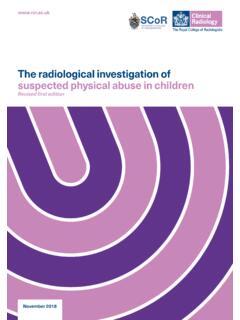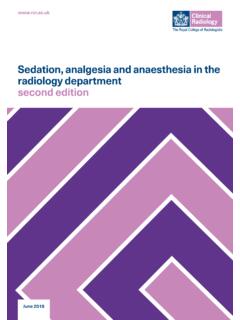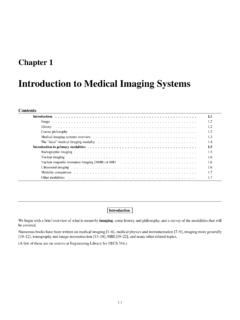Transcription of Guidance on screening and symptomatic breast imaging ...
1 November 2019 Guidance on screening and symptomatic breast imagingFourth editionContentsForeword 3 Introduction 41. Investigation of breast symptoms 52. Population screening 83. Higher risk and risk-adapted screening 94. screening assessment 115. Staging of breast cancer 126. Monitoring of response to neoadjuvant drug treatment 147.
2 imaging follow-up after breast cancer treatment 148. Assessment and follow-up of metastatic disease 16 References 17 Appendix 1. Classification of imaging findings 20 Appendix 2. breast MRI protocol and reporting guidelines 21 Appendix 3. Radiation risks in mammography 22 Appendix 4. Professional standards 23 Terminology 26 Acknowledgements 263 Guidance on screening and symptomatic breast imaging Fourth fourth edition of Guidance on screening and symptomatic breast imaging is an update on the previous three editions, published in 1999, 2003 and 2013.
3 It reflects the significant advances in technology and the role of imaging , image-guided diagnosis and intervention in the six years since the previous publication. The ongoing changes in the NHS breast screening Programme, risk-adapted and higher risk screening , indications for MRI and CT staging as well as post-cancer surveillance rationale are highlighted. The radiation risks associated with mammography are included in an appendix and can be used to provide the patient information required under IR(ME)R am extremely grateful to Dr Anthony Maxwell and members of the British Society of breast Radiology for their help in revising and updating this Caroline Rubin Vice-President, Faculty of Clinical RadiologyForeword4 Guidance on screening and symptomatic breast imaging Fourth document replaces the RCR s previous Guidance on screening and symptomatic breast imaging , Third Edition (BFCR(13)5), which is now withdrawn.
4 Significant changes have occurred in screening , the investigation of patients with suspected breast disease and the treatment of patients with breast cancer since the last edition, necessitating a complete revision of the Guidance . This now includes recommendations for the investigation of patients presenting with breast on screening and symptomatic breast imaging Fourth Diagnostic assessment of patients with breast symptoms is based on triple assessment (clinical assessment, imaging and needle biopsy).
5 1 The tests used in each case are determined by the symptoms, clinical findings and age of the imaging facilities should include digital mammography and high frequency ultrasound with probes suitable for breast imaging (12 MHz or more). The technical quality of mammography should be equivalent to that in the National Health Service breast screening Programme (NHSBSP). digital breast tomosynthesis (DBT) and contrast-enhanced spectral mammography (CESM) may also be used in the symptomatic setting, where assessment imaging should be carried out by suitably trained members of the multidisciplinary team.
6 Ultrasound is the firstline imaging modality of choice in women aged <40 years and during pregnancy and lactation. imaging in pregnant and lactating patients is difficult to interpret and a lower threshold should be used for clinical and imaging follow-up and/or biopsy. Mammography is the firstline imaging modality of choice in women aged 40 years or over, with the addition of ultrasound as indicated. Mammography should be performed on all patients with confirmed malignancy, irrespective of age. Mammography should be performed on patients aged 35 39 years with clinically suspicious findings (P4 or P5) and/or ultrasonically suspicious (U4 or U5) findings, preferably prior to biopsy.
7 Mammography should include mediolateral oblique (MLO) and craniocaudal (CC) views of each breast . If a suspicious abnormality is identified on mammography it may be helpful to perform further mammographic views (magnification, compression or digital breast tomosynthesis [DBT]) to help characterise the abnormality. DBT or CESM may be used as a firstline investigation instead of mammography in women with clinically suspicious findings, especially in younger women who are more likely to have dense breasts, according to local protocols.
8 The level of suspicion for malignancy should be recorded using the British Society of breast Radiology (BSBR, previously the Royal College of Radiologists breast Group) imaging classification U1 U5 and M1 M5 (Appendix 1). Ultrasound of the axilla should be carried out in all patients when malignancy is suspected or confirmed. If lymph nodes showing abnormal morphology on ultrasound are found, tissue sampling of at least one abnormal node should be performed under ultrasound Guidance . There is no agreed threshold for cortical thickness, this varying from 2 to 4 mm between centres, although most use between and 3 mm.
9 The threshold should be determined locally and audited to achieve a suitable balance between resultant axillary clearances for low-volume disease without prior surgical sentinel lymph node biopsy (with a low threshold cortical thickness) and excessive numbers of axillary clearances as second operations (with a high threshold cortical thickness). The imaging report should document the number of abnormal Investigation of breast symptoms6 Guidance on screening and symptomatic breast imaging Fourth biopsy Clinical and imaging work-up should be completed before needle biopsy is performed.
10 breast needle biopsies should be performed under image Guidance ultrasound or X-ray (stereotaxis or tomosynthesis) guided. Core biopsy of both breast lesions and axillary lymph nodes should be performed rather than fine-needle aspiration cytology (FNAC) as it provides higher sensitivity and specificity and also provides important prognostic oncological information (tumour type, grade and receptor status) that can determine treatment. Freehand core biopsy is indicated in cases where imaging is normal but there is an indeterminate or suspicious clinical abnormality (P3 or above, confirmed if necessary on senior surgical review).


















